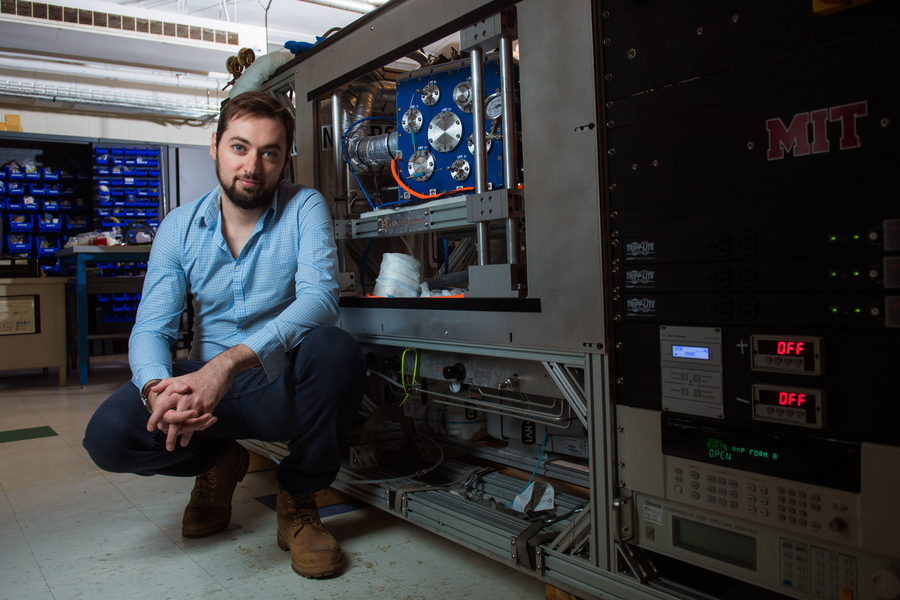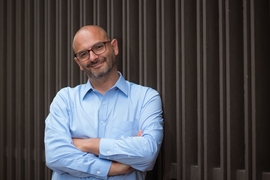To launch extended missions in space, the National Aeronautics and Space Administration (NASA) is borrowing a page from the nuclear engineering industry: It is trying to understand how boiling works.
Planning for long-term missions has NASA researching ways of packing the least amount of cryogenic fuel possible for efficient liftoff. One potential solution is to refuel the rocket in space using fuel depots placed in low Earth orbits. This way, the spacecraft can carry the lightest fuel load — enough to reach the low Earth orbit to refuel as necessary and complete the mission. But refueling in space requires a thorough knowledge of cryogenic fuels.
“We [need to understand] how boiling of cryogens behaves in microgravity conditions [encountered in space],” says Florian Chavagnat, a sixth-year doctoral candidate in the Department of Nuclear Science and Engineering (NSE). After all, understanding how cryogens boil in space is critical to NASA’s fuel management strategy. The vast majority of studies on boiling evaluate fluids that boil at high temperatures, which doesn’t necessarily apply to cryogens. Under the advisement of Matteo Bucci and Emilio Baglietto, Chavagnat is working on NASA-sponsored research about cryogens and the way the lack of buoyancy in space affects boiling.
A childhood spent tinkering
A deep understanding of engineering and physical phenomena is exactly what Chavagnat developed growing up in Boussy-Saint-Antoine, a suburb of Paris, with parents who worked for SNCF, the national state-owned rail company. Chavagnat remembers discussing the working of trains and motors with his engineer dad and building a variety of balsa-wood models. One of his memorable projects was a sailboat propelled by a motor from an electric toothbrush.
By the time he was a teenager, Chavagnat received a metal lathe as a gift. His tinkering became an obsession; a compressed air engine was a favorite project. Soon his parents’ small shed, meant for gardening, became a factory, Chavagnat recalls, laughing.
A lifelong love of math and physics propelled a path to the National Institute of Applied Science in Rouen, Normandy, where Chavagnat studied energetics and propulsion as part of a five-year engineering program. In his final year, Chavagnat studied atomic engineering from INSTN Paris-Saclay, part of the esteemed French Alternative Energies and Atomic Energy Commission (CEA).
The final year of studies at CEA required a six-month-long internship, which traditionally sets the course for a job. Chavagnat decided to take a chance and apply for an internship at MIT NSE instead, knowing his future course might be uncertain. “I didn’t take a lot of risk in my life, but this one was a big risk,” Chavagnat says. The gamble paid off: Chavagnat won the internship with Charles Forsberg, which paved the way for his admission as a doctoral student. “I selected MIT because it has always been my dream school,” Chavagnat says. He also enjoyed the idea of challenging himself to improve his English-speaking skills.
A love of physics and heat transfer
Chavagnat loves physics — “if I can study any problem in physics, I’d be happy” he says — which led him to working on heat transfer, more specifically on boiling heat transfer. His early doctoral research focused on transient boiling in nuclear reactors, part of which has been published in the International Journal of Heat and Mass Transfer.
Chavagnat’s research targets a specific kind of nuclear reactor called a material test reactor (MTR). Nuclear scientists use MTRs to understand how materials used in plant operations might behave under long-term use. Densely packed nuclear fuel, running at high power, simulates long-term effects using a very intense neutron flux.
To prevent failure, operators limit reactor temperature by flowing very cold water at high velocity. When reactor heat power increases uncontrollably, the piped water begins to boil. Boiling works to prevent meltdown by altering neutron moderation and extracting heat from the fuel. “[Unfortunately], that only works until you reach a certain heat flux at the fuel cladding, after which the efficiency completely drops,” Chavagnat says. Once the critical heat flux is reached, water vapor starts to blanket and insulate the fuel elements, leading to rapidly rising cladding temperatures and potential burnout.
The key is to figure out the behavior of maximum boiling heat flux under routine MTR conditions — cold water, high flow velocity, and narrow spacing between the fuel elements.
Study of cryogenic boiling
Boiling continues to occupy center stage as Chavagnat pursues the question for NASA. Cryogens boil at very low temperatures, so the question of how to prevent fuel loss from routine space-based operations is an important one to answer.
Chavagnat is studying how boiling would behave under reduced or absent buoyancy, which are the conditions cryogenic rocket fuel will encounter in space.
To reproduce space-like conditions on Earth, buoyancy can be modified without going to space. Chavagnat is manipulating the inclination of the boiling surface — placing it upside down is an example — such that buoyancy does not do what it usually does: help bubbles break away from the surface. He is also performing boiling experiments in parabolic flights to simulate microgravity, similar to what is experienced aboard the International Space Station.
Chavagnat designed and built equipment which can perform both methods with minimum changes. “We observed nitrogen boiling on our surface by imaging it using two high-speed video cameras,” he says. The experiment was approved to go on board the parabolic flights operated by Zero-G, a company that operates weightless flights. The team successfully completed four parabolic flights in 2022.
“Flying an experiment aboard an aircraft and operating it in microgravity is an incredible experience, but is challenging,” Chavagnat says, “Knowing the details the experiment is a must, but other skills are quite useful — in particular, working as a team, being able to manage high stress levels, and being able to work while being motion-sick.” Another challenge is that the majority of issues cannot be fixed once aboard, as aircraft pilots perform the parabola (each lasting 17 seconds) almost back-to-back.
Throughout his research at MIT, Chavagnat has been captivated by how complex a simple phenomenon like boiling can truly be. “In your childhood, you have a certain idea of how boiling looks, relatively slow bubbles that you can see with the naked eye,” he says, “but you don’t realize the complexity until you see it with your own eyes.”
In his infrequent spare time, Chavagnat plays soccer with the NSE’s team, the Atom Smashers. The group meets only five times a semester so it’s a low-key commitment, says Chavagnat who spends most of his time at the lab. “I am doing mostly experiments at MIT; it turns out the skills I learned in my shed when I was 15 are actually quite useful here,” he laughs.













